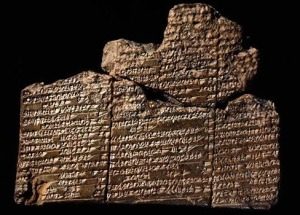
In honor of the first visit by Pope Francis and the World Meeting of Families in Philadelphia, the Penn Museum (University of Pennsylvania Museum of Archaeology and Anthropology) is offering a special focus on the ancient Near East, Egypt, and the Bible Lands—with a limited-time-only display of rare artifacts from the collections of the University of Pennsylvania and the Penn Libraries’ collections, for public viewing.
A centerpiece exhibition, Sacred Writings: Extraordinary Texts of the Biblical World, illustrates the many ways the Bible—and stories akin to those in the Bible—have been represented over time and across continents.
Highlights of the exhibition include the following:
From the Penn Museum:
- One of the world’s oldest fragments of the gospel of Saint Matthew, written on papyrus and dating to the 3rd century CE. Once part of a codex (book), this fragment, written in ancient Greek, contains the beginning of the Gospel of Matthew (Ch 1. Verses 1-9, 12, 14-20), which begins with the lineage of Jesus, then describes how Mary became with child by the Holy Spirit.
- An ancient clay tablet in Sumerian cuneiform from the site of Nippur in Mesopotamia (now in Iraq), ca. 1650 BCE, containing the earliest version of the Mesopotamian flood story. A version of this tale became incorporated into the Epic of Gilgamesh, and tells of a flood that destroyed humankind; the story closely parallels the biblical story of Noah.
- Two folios from a richly decorated, illuminated Qur’an from Iran, copied and signed by its scribe in Hamadan in 1164. The copy is written with black ink in cursive Naskh Arabic script, and features the complete text of the Qur’an, with commentary in red script. The exhibited pages feature the Surah Nuh (Noah), with a mention of the Flood and Noah’s role as admonisher.
From the Penn Libraries’ collections:
- An illuminated Latin Bible produced in Arras, France in the late 13th century.
- The first authorized Roman Catholic translation of the New Testament Bible into English, printed at Reims, France, through the efforts of English Catholic exiles, in 1582.
- The first complete Bible printed in the New World, a translation of the Bible into the Native American Massachusett language by Puritan missionary John Eliot in 1663.
- A polyglot New Testament Bible compiled by German scholar Elias Hutter with side by side text in twelve languages—Syriac, Hebrew, Greek, Latin, German, Czech, Italian, Spanish, French, English, Danish, and Polish—printed in Nuremberg in 1599.
- A late 15th century Italian illustrated manuscript copy of Werner Rolevinck’s history of the world detailing events from the creation to the election of Pope Sixtus IV.
- An early 16th century Rabbinic Bible from the famed Hebrew printing house of Daniel Bomberg in Venice, Italy.
- A limited edition contemporary Bible from the Pennyroyal Caxton Press, 1999, designed and illustrated by Barry Moser.
________________________________________
 Exhibited: An ancient clay tablet in Sumerian cuneiform from the site of Nippur in Mesopotamia (now in Iraq), circa 1650 BCE, contains the earliest version of the Mesopotamian flood story. A version of this tale became incorporated into the Epic of Gilgamesh, and tells of a flood that destroyed humankind—the story closely parallels the biblical story of Noah. Photo: Penn Museum
Exhibited: An ancient clay tablet in Sumerian cuneiform from the site of Nippur in Mesopotamia (now in Iraq), circa 1650 BCE, contains the earliest version of the Mesopotamian flood story. A version of this tale became incorporated into the Epic of Gilgamesh, and tells of a flood that destroyed humankind—the story closely parallels the biblical story of Noah. Photo: Penn Museum
______________________________________________________
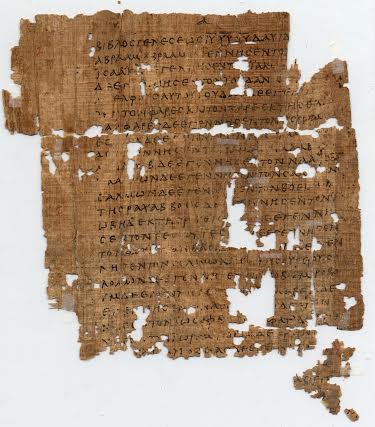 _________________________________________________________
_________________________________________________________
Exhibited: The Gospel of Matthew fragment: This papyrus fragment was discovered by Grenfell and Hunt (of the Egyptian Exploration Fund) at the site of Oxyrhynchus in 1897 at the beginning of several seasons of excavations that took place at the site from 1896-1907. The Penn Museum was a supporter of the EEF, and as a result received materials from EEF excavations. This is how the Penn Museum came to house this papyrus in the collection.
The name Oxyrhynchus (meaning “bent-nose”) comes from a type of fish that was sacred to the ancient Egyptians. The site of Oxyrhynchus is about 100 miles south of Cairo. Today the modern village of el-Behnesa occupies part of the ancient site.
Oxyrhynchus became an important center during the Greco-Roman Period. In later antiquity, it was well-known for its many churches and monasteries. The excavators chose to work at the site because of its reputation as an important Christian site, and hoped to locate early Christian texts.
Working largely in ancient trash dumps, Grenfell and Hunt discovered a wealth of written material – more than 40,000 fragments written in a variety of scripts including Greek, Latin, Demotic, Coptic, Hebrew, Syriac and Arabic. This material dates mostly to the period of 250 BC to AD 700. A number of important documentary and classical literary texts were found here.
Grenfell and Hunt’s excavations also discovered a wide range of early Christian literature. The second day of the first season of work at the site unearthed this fragment, the beginning of the Gospel of St. Matthew, which at the time of its discovery was the oldest text of the New Testament ever discovered, dating to the third century CE. (This fragment is not the only New Testament text found at the site, but it remains one of the very oldest. Excavators there subsequently uncovered another 27 New Testament papyri fragments.)
The Penn fragment contains Matthew 1:1-9, 12 and 13, 14-20, which gives the genealogy of Jesus. It is written on both sides of the papyrus. The pages are numbered at the top with a Greek letter α (page 1) and β (page 2) indicating that the papyrus’ original format was that of a codex (or book), rather than a scroll. The text is written in Greek uncial writing, with all of the letters in capitals, with no spaces in between words. The name of Jesus Christ is abbreviated IY XY with a superscript line above the letters.
The Sackler Library at Oxford houses most of the Oxyrhynchus papyri. The Penn Museum received this fragment as well as over 50 other Oxyrhynchus papyri from these excavations. Photo Penn Museum E2746 P1
_______________________________________________________
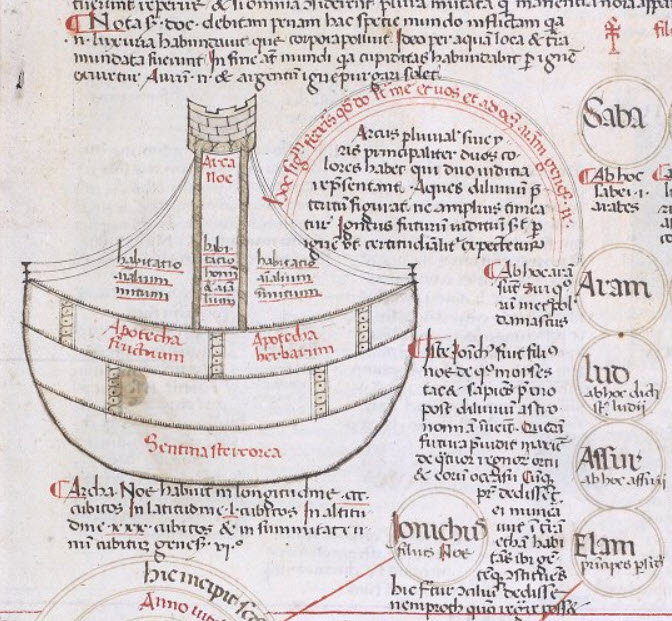 Exhibited: An enlarged diagram of the ark associated with the biblical story of Noah in a late 15th century manuscript copy documenting the history of the world. The manuscript copy spans from the creation to the election of Pope Sixtus IV. Credit: From Penn Libraries’ Kislak Center for Special Collections, Rare Books and Manuscripts
Exhibited: An enlarged diagram of the ark associated with the biblical story of Noah in a late 15th century manuscript copy documenting the history of the world. The manuscript copy spans from the creation to the election of Pope Sixtus IV. Credit: From Penn Libraries’ Kislak Center for Special Collections, Rare Books and Manuscripts
_____________________________________________________
In addition to the special exhibition, visitors interested in the biblical era and region may also view rare art, artifacts and large-scale photographs in several galleries: the Museum’s renowned Egypt (Sphinx) gallery and a side gallery, Amarna, Ancient Egypt’s Place in the Sun; Iraq’s Ancient Past: Rediscovering Ur’s Royal Cemetery; Canaan and Ancient Israel; and Sacred Spaces: The Photography of Ahmet Ertug, featuring large-scale photographs of Byzantine-era churches in Constantinople (Istanbul) and the Cappadocia region of Turkey.
The exhibition is on view to the public August 15 through November 7, 2015.
______________________________________________________
The Penn Museum is located at 3260 South Street in Philadelphia, PA.
Source: Edited and adapted from Sacred Writings: Extraordinary Texts from the Biblical World, Penn Museum.
______________________________________________________
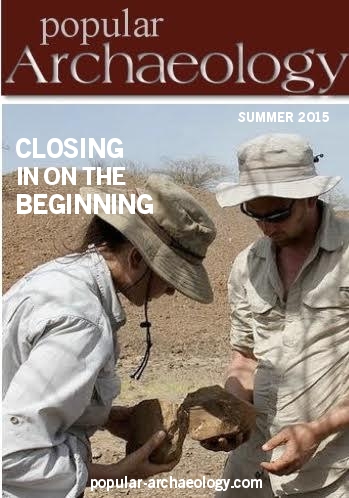 Read more in-depth articles about archaeology with a premium subscription to Popular Archaeology Magazine.
Read more in-depth articles about archaeology with a premium subscription to Popular Archaeology Magazine.
In addition, the latest Popular Archaeology ebook is now available.
______________________________________________
Travel and learn with Far Horizons.
____________________________________________
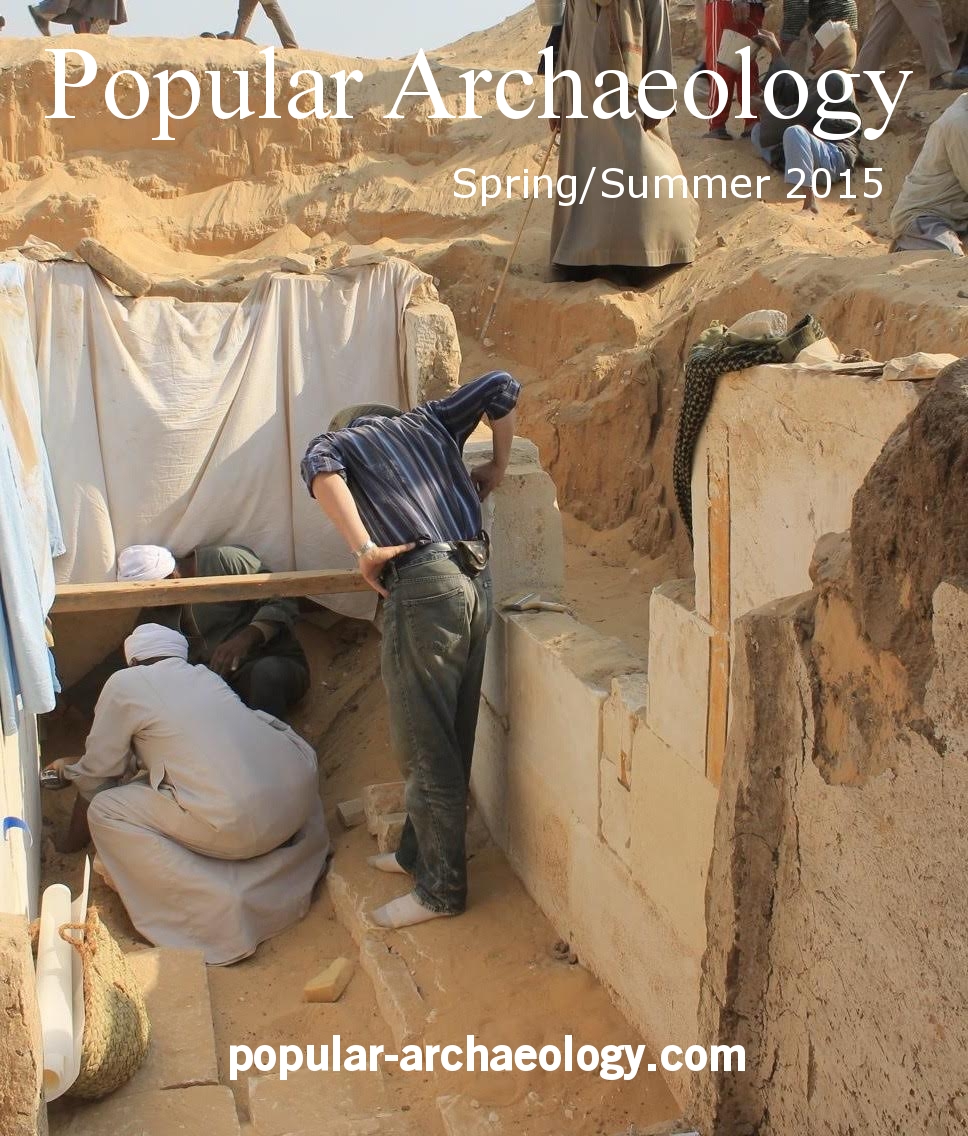 This richly illustrated ebook version of a recent Popular Archaeology issue includes the following stories: The discovery of the tomb of a previously unknown pharaoh that is shedding light on a lost ancient Egyptian dynasty; how genetics is revolutionizing what we know about human evolution and our prehistoric past; one scholar’s controversial ‘New Chronology’ and how it supports the historicity of the biblical Exodus; how archaeologists are unearthing new history in Williamsburg, Virginia, a seat of British colonial power in 18th century America; the discovery of the remains of a major Roman legionary base in Israel; the unearthing of an ancient Judean fortified settlement in the borderlands between the biblical kingdoms of ancient Judah and the Philistines; and how archaeologists are uncovering evidence of what may have been an important administrative center of Judah during the 8th century BCE. Now available from Amazon.com!
This richly illustrated ebook version of a recent Popular Archaeology issue includes the following stories: The discovery of the tomb of a previously unknown pharaoh that is shedding light on a lost ancient Egyptian dynasty; how genetics is revolutionizing what we know about human evolution and our prehistoric past; one scholar’s controversial ‘New Chronology’ and how it supports the historicity of the biblical Exodus; how archaeologists are unearthing new history in Williamsburg, Virginia, a seat of British colonial power in 18th century America; the discovery of the remains of a major Roman legionary base in Israel; the unearthing of an ancient Judean fortified settlement in the borderlands between the biblical kingdoms of ancient Judah and the Philistines; and how archaeologists are uncovering evidence of what may have been an important administrative center of Judah during the 8th century BCE. Now available from Amazon.com!
____________________________________________







